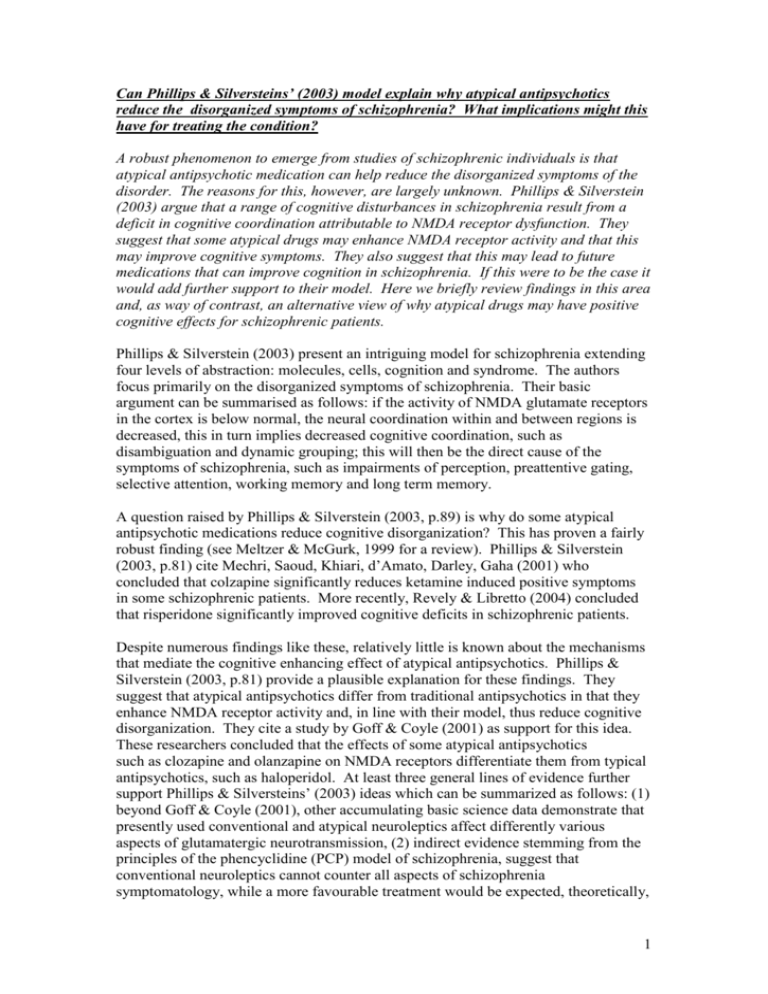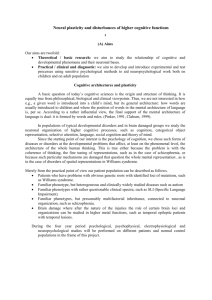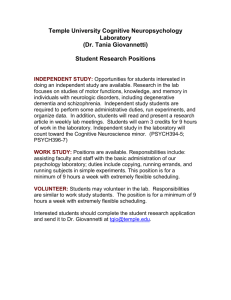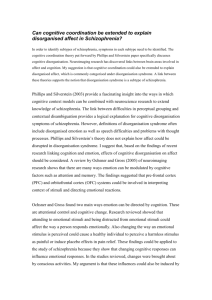Gary Britton, Student Number 20301679, BA Psychology, Summer
advertisement

Can Phillips & Silversteins’ (2003) model explain why atypical antipsychotics reduce the disorganized symptoms of schizophrenia? What implications might this have for treating the condition? A robust phenomenon to emerge from studies of schizophrenic individuals is that atypical antipsychotic medication can help reduce the disorganized symptoms of the disorder. The reasons for this, however, are largely unknown. Phillips & Silverstein (2003) argue that a range of cognitive disturbances in schizophrenia result from a deficit in cognitive coordination attributable to NMDA receptor dysfunction. They suggest that some atypical drugs may enhance NMDA receptor activity and that this may improve cognitive symptoms. They also suggest that this may lead to future medications that can improve cognition in schizophrenia. If this were to be the case it would add further support to their model. Here we briefly review findings in this area and, as way of contrast, an alternative view of why atypical drugs may have positive cognitive effects for schizophrenic patients. Phillips & Silverstein (2003) present an intriguing model for schizophrenia extending four levels of abstraction: molecules, cells, cognition and syndrome. The authors focus primarily on the disorganized symptoms of schizophrenia. Their basic argument can be summarised as follows: if the activity of NMDA glutamate receptors in the cortex is below normal, the neural coordination within and between regions is decreased, this in turn implies decreased cognitive coordination, such as disambiguation and dynamic grouping; this will then be the direct cause of the symptoms of schizophrenia, such as impairments of perception, preattentive gating, selective attention, working memory and long term memory. A question raised by Phillips & Silverstein (2003, p.89) is why do some atypical antipsychotic medications reduce cognitive disorganization? This has proven a fairly robust finding (see Meltzer & McGurk, 1999 for a review). Phillips & Silverstein (2003, p.81) cite Mechri, Saoud, Khiari, d’Amato, Darley, Gaha (2001) who concluded that colzapine significantly reduces ketamine induced positive symptoms in some schizophrenic patients. More recently, Revely & Libretto (2004) concluded that risperidone significantly improved cognitive deficits in schizophrenic patients. Despite numerous findings like these, relatively little is known about the mechanisms that mediate the cognitive enhancing effect of atypical antipsychotics. Phillips & Silverstein (2003, p.81) provide a plausible explanation for these findings. They suggest that atypical antipsychotics differ from traditional antipsychotics in that they enhance NMDA receptor activity and, in line with their model, thus reduce cognitive disorganization. They cite a study by Goff & Coyle (2001) as support for this idea. These researchers concluded that the effects of some atypical antipsychotics such as clozapine and olanzapine on NMDA receptors differentiate them from typical antipsychotics, such as haloperidol. At least three general lines of evidence further support Phillips & Silversteins’ (2003) ideas which can be summarized as follows: (1) beyond Goff & Coyle (2001), other accumulating basic science data demonstrate that presently used conventional and atypical neuroleptics affect differently various aspects of glutamatergic neurotransmission, (2) indirect evidence stemming from the principles of the phencyclidine (PCP) model of schizophrenia, suggest that conventional neuroleptics cannot counter all aspects of schizophrenia symptomatology, while a more favourable treatment would be expected, theoretically, 1 with the use of agents that target glutamatergic transmission and (3) the results of the first decade of clinical research with glutamatergic agents targeting the NMDA receptor indicate that these types of compounds have efficacy and side-effects different from those of presently used antipsychotics and may actually represent a new class of atypical antipsychotic medication. If enhancement of NMDA medicated neurotransmission represents one of the mechanisms by which atypical antipsychotics have their cognitive enhancing effects, then the addition of glycine site agonists, which act as an NMDA agonists, to the treatment of patients receiving atypical drugs should be less beneficial than adding glycine site agonists to those on traditional neuroleptics. Unfortunately, few studies have studied the effects of glycine agonists with traditional antipsychotics, probably as their use is rapidly in decline. However, Levy (2003) reviews those which have and concludes that glycine agonists have much more profound effects on those treated with typical as opposed to atypical medication. It is worthy of note, however, that benefits were more significant for positive and negative than disorganized symptoms. Phillips & Silverstein (2003) remark that if pharmological interventions at glutamate receptors can improve disorganized symptoms, this may provide a new line of medical treatment for schizophrenia. They leave this line of enquiry very much open. Recent studies exploring this area have tended to examine the role of NMDA enhancing properties along with atypical antipsychotics, presumably to show that they have effects above and beyond those of atypical antipsychotics. Most seem to broadly support Phillips & Silversteins’ ideas. Jarvitt (cited in Philips & Silverstein, 2003, p.93) provides data which suggests that glycine reverses impairments on the MMN and AX-CPT paradigms, suggesting that agents that enhance NMDA activity can improve cognitive coordination. Since Phillips & Silversteins' (2003) article, several other findings have been made. Tsai, Lane, Yang, Chong, Lange (2004) report that surcosine (which enhances NMDA activity through a complex interaction with glycine) improves cognitive function in schizophrenic patients. Coyle (2004) reports that D-cycloserine (a partial NMDA agonist) and glycine have proven partially successful in reducing negative and cognitive symptoms in schizophrenia. Heresco-Levy, Ermilov, Lichtenberg, Bar & Javitt (2004) report a 9 reduction in cognitive symptoms when glycine was added to risperidone or olanzapine. Heresco-Levy, Javitt, Ebstien, Vass, Lichenberg, Bar, Catinari, Ermilov (2005) point out potential problems with D-cycloserine and glycine, namely that both may affect other receptor sites. They studied the effect of D-Serine, which is not known to interact with any other neurotransmitter system except NMDA, along with risperidone or olanzapine and reported an 11% reduction in cognitive symptoms. Most recently, Kremer, Vass, Gorelik, Bar, Blanaru, Javitt, Heresco-Levy (2005) reported that lamotrigine, a novel anticonvulsant drug which enhances NMDA activity, had the effect of reducing cognitive symptoms, although not to a significant level, when added to clomzapine. Unfortunately, despite the promise of the above findings in terms of producing a new line of medication aimed at reducing disorganized symptoms in schizophrenia, Jarvitt & Coyle (2004) point out that none of the agents studied to date have the properties 2 needed for commercialisation because, for example, for many the doses required are simply to high. Despite the above findings, which seem to offer some support for Phillips & Silversteins’ (2003) model, it should be noted that other proposals have been put forward to explain why atypical antipsychotics reduce disorganized symptoms. For example, it has been argued that the preponderance of serotonin (5-HT)-2A antagonism over dopamine (DA)-2 blockade excerted by atypical antipsychotics may enhance dopamengeric output in the pre-frontal cortex and this may account, at least in part, for their beneficial cognitive effects in schizophrenia (Ruiu, Marchese, Saba, Gessa, Pani, 2000). There is some support for this hypothesis. Poyurovsky, Koren, Gonopolsky, Schniedman, Fuchs, Weizman & Weizman (2003) concluded that that the addition of mianserin, a 5-HT2A antagonist, to atypical antipsychotics added significantly to their cognitive enhancing effect. Chaudhry, Soni, Hellewell & Deakin (2002) using a different cognitive battery and 5-HT2A antagonist, cypohepadine, reached similar conclusions with chronic neuroleptic treated patients. These findings seem to be most easily accommodated by the model by Braver, Barch & Cohen (1999) who suggest that some of the cognitive deficits in schizophrenia arise from reduced dopamengeric modulation in the pre-frontal cortex. Phillips & Silverstein would no doubt interject here and point out that as the glutamatergic system closely interacts with and modulates other systems, NMDA hypofunction may well effect dopamine dysregulation. Therefore, 5-HT2A antagonists may be simply modulating a effect of NMDA hypofunction. Whilst the intricacies of the above argument are beyond the scope of this review it serves to make a good point. Drug development for schizophrenia needs to advance in the direction of targeting complex, interactive neurotransmitter systems like glutamate and dopamine. By manipulating the physiological and biochemical mechanisms that are proximal to the underlying disease, we are more likely to obtain therapeutic results that significantly enhance cognitive performance. In addition, as Levy (2003) indicates, with regard to the relationship between atypical antipsychotics and NMDA receptor agonists, future studies need to compare full versus partial agonists of the glycerine site and, perhaps more importantly, include the assessment of glycerine site modulators as mono versus add-on therapy. Bibliography 3 Braver, T. S., Barch, D. M. & Cohen, J. D. (1999) Cognition and control in schizophrenia: a computational model of dopamine and prefrontal function. Biological Psychiatry 46 :312-28 Chaudhry IB, Soni SD, Hellewell JSE, Deakin JFW. (2002) Effects of the 5HT antagonist cyproheptadine of neuropsychological function in chronic schizophrenia. Schizophrenia Re 53:17-24. Coyle, J, T (2004) The GABA-glutamate connection in schizophreina: which is the proximate cause, Biochem. Pharmcol. 68, pp.1507-1514. Goff, D. C. & Coyle, J. T. (2001) The emerging role of glutamte in the pathophysiology and treatment of schizophrenia. American Journal of Psychiatry 158:1367-77. Heresco-Levy, U, Ermilov, M. Lichtenberg, P. Bar, G. & Javitt, D.C. (2004) High dose glycine added to olanzapine and resperidone for the treatment of schziophrenia, Bilo Psychiatry, 55, pp.165-177. Javitt, D,C. & Coyle, Scientific American Magazine, January 2004 Issue. Kremer, I, Vass, A, Gorelik, I, Bar, G, Blanaru, M, Javitt, D, C, Heresco-Levy, U, (2005) Placebo-controlled trial of lamotrigine added to conventional and atypical antipsychotics in schziophrenia. Biological Psychiatry. 56, Issue 6, p 411-446. Heresco-Levy, U, (2003), Glutamatergic neurotransmission modulation and the mechanism of antipsychotic atypicality. Progress in Neuro-Psychopharmacology and Biological Psychiatry, 27, Issue 7, pp. 1113-1123. Heresco-Levy, U, Javitt, D,C, Ebstien, R, Vass, A, Lichtenberg, P, Bar, G, Catinari, S, Ermilov, M. (2005), D-serine efficacy as add-on pharmacotherapy to risperidone and olanzapine for treatment-refactory schizophrenia, Biological Psychiatry, 57, pp.577585. Mechri, A., Saoud, M., Khiari, G., d'Amato, T., Dalery, J. & Gaha, L. (2001) Glutaminergic hypothesis of schizophrenia: studies with ketamine. Encephale 27:53-9. Meltzer HY, McGurk SR. The effects of clozapine, risperidone, and olanzapine on cognitive function in schizophrenia. Schizophr Bull 1999;25:233-255. Phillips, W, A & Silverstein, S, M, (2003) Convergence of biological and psychological perspectives on cognitive coordination in schizophrenia, Behavioral and Brain Sciences, Volume 26, Number 1: 65-82 (Feburary 2003) Poyurovsky, M, Koren, D, Gonopolsky, I, Schneidman, M, Fuchs, C, Weizman, A, Weizman, R (2003) Effect of the 5-HT2 antagonist mianserin on cognitive 4 dysfunction in chronic schizophreic patients: an add-on, double-blind placebocontrolled study, European Neuro-Psychopharmacology, 13, pp.123-128. Revely, M,A & Libretto, S, E (2004) Treatment outcome in patients with chronic schizophrenia during long-term adminsitraion of risperidone, Journal of Psychopharmacology, 24 (3), pp.245-253. Ruiu, S, Marchese, G, Saba, P.L, Gessa, G.L, Pani, L, (2000), The 5-ht2 antagonist ritanserin blocks dopamine reuptake in the frontal rat cortex. Mol. Psychiatry, 5, pp.673-677. Tsai, G, Lane, H, Yang, P, Chong, M, Lange, N, (2004), Glycine transporter I inhibitor, N-Methylglycine (sarcosine), added to antipsychotics for the treatment of schizophrenia. Biological Psychiatry, 55, pp. 452-456. 5







